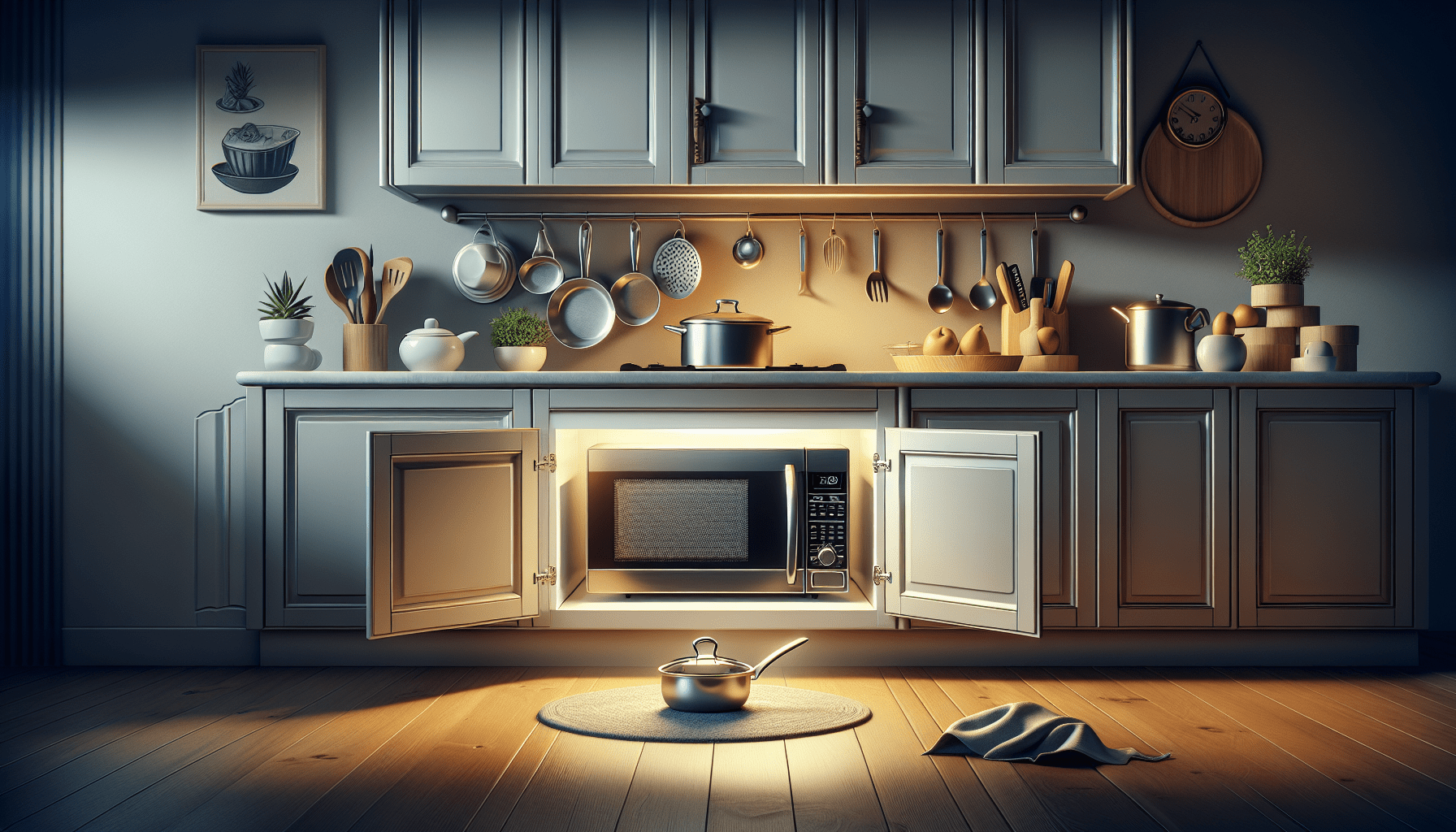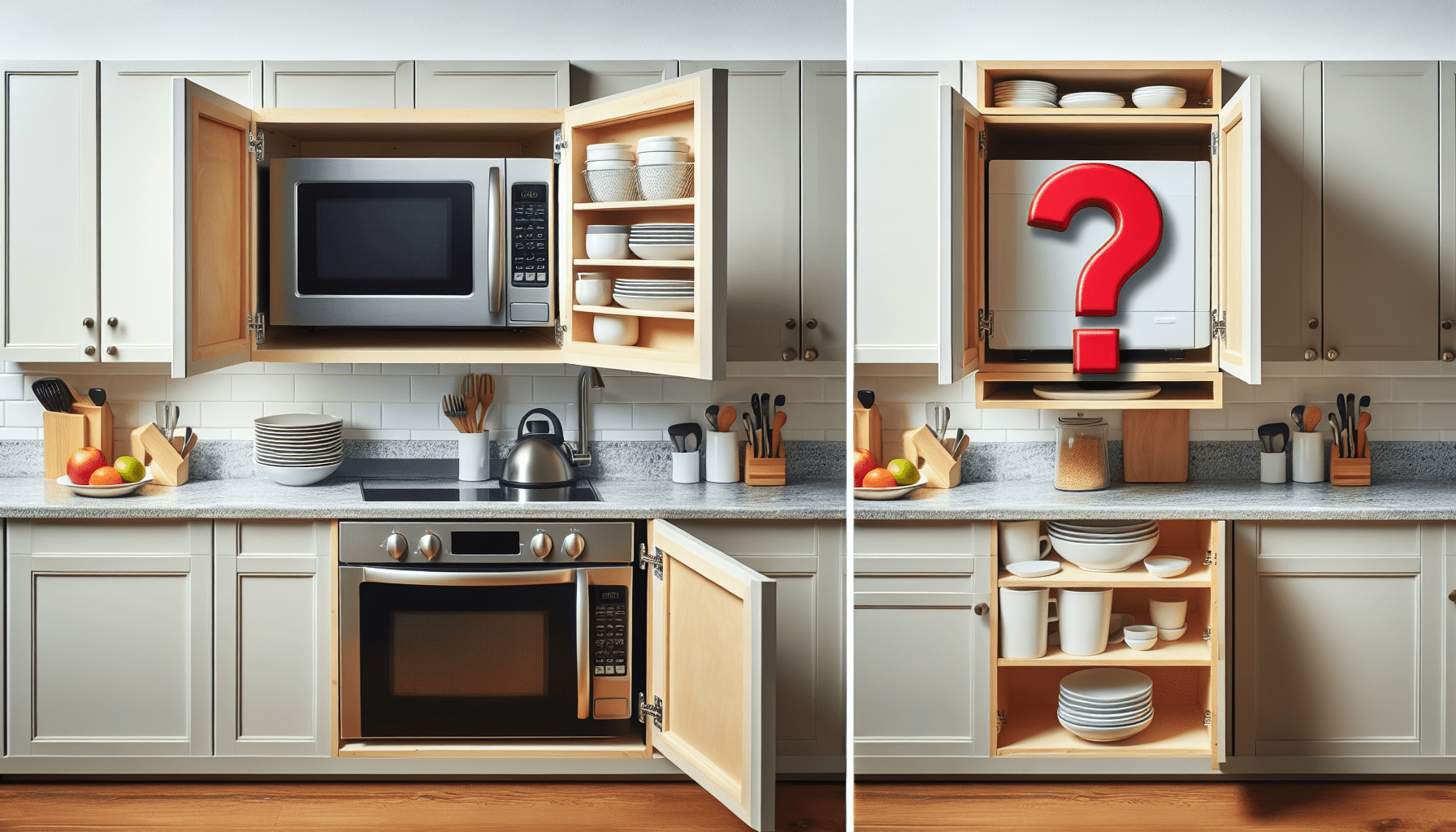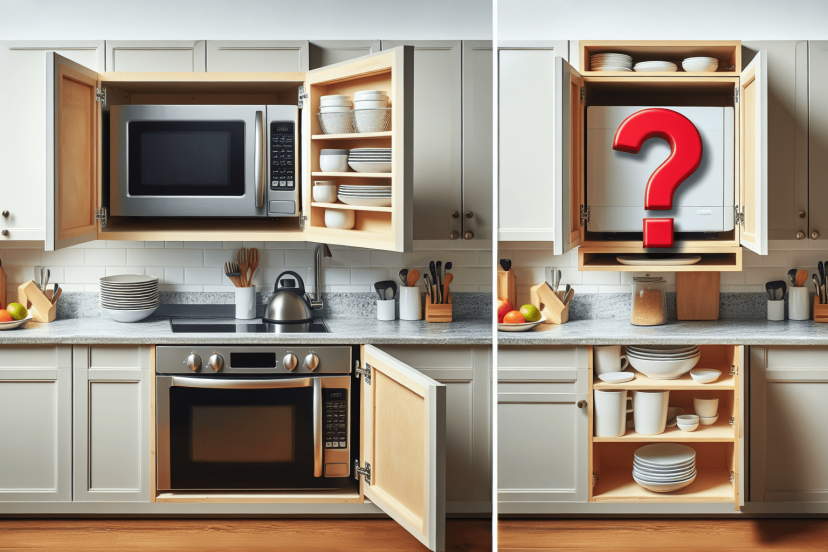Is It Safe To Put A Countertop Microwave In A Cabinet?
Have you ever wondered if it’s safe to put a countertop microwave in a cabinet? Many of us have limited counter space in our kitchens, and the idea of freeing up that valuable surface area by tucking away the microwave seems enticing. However, before you go ahead and make the move, it’s important to consider the safety implications. In this article, we will explore the potential risks and benefits of placing a countertop microwave in a cabinet to help you make an informed decision for your kitchen setup.

Considerations for Putting a Countertop Microwave in a Cabinet
Microwaves are a staple in many kitchens, providing convenience and efficiency when it comes to cooking and reheating food. However, you may find yourself wondering if it is safe to put a countertop microwave in a cabinet. While it may seem like a practical solution to save counter space and create a sleeker kitchen aesthetic, there are several important considerations to keep in mind before making this decision. In this article, we will explore various factors that need to be taken into account, including microwave size and cabinet space, ventilation and heat dissipation, electrical requirements, safety precautions, and discuss the benefits and drawbacks of putting a countertop microwave in a cabinet.
Microwave Size and Cabinet Space
Measurements and Fit
The first consideration when thinking about putting a countertop microwave in a cabinet is whether the microwave will fit within the cabinet space. Measure the dimensions of both the microwave and the cabinet accurately to ensure a proper fit. Keep in mind that you may need to provide additional clearance to ensure ease of use and proper ventilation, which we will discuss further in the next section.
Clearance and Accessibility
It is essential to consider the clearance required for safe and convenient usage of the microwave. The microwave’s door should have enough space to open fully without any obstructions, allowing you to easily place and remove items from inside. Additionally, consider the height of your cabinet and check if it is at an appropriate level for easy accessibility. You don’t want to strain yourself or risk accidents while using the microwave.
Ventilation and Heat Dissipation
Importance of Ventilation
Proper ventilation is crucial when it comes to safely using a microwave. Microwaves generate a significant amount of heat during operation, and without adequate ventilation, this heat can build up inside the cabinet and potentially cause damage. It could also decrease the overall lifespan of the microwave. Therefore, it is important to ensure proper ventilation to prevent overheating and allow for the dissipation of heat.
Heat Dissipation Mechanisms
There are various mechanisms that help dissipate the heat generated by a microwave. Countertop microwaves typically have built-in fans and vents that release heat directly into the surrounding environment. When placing a countertop microwave in a cabinet, these heat dissipation mechanisms may not function optimally due to limited air circulation. The lack of ventilation can cause the microwave to overheat, leading to potential performance issues and even safety hazards.
Built-in Cabinet Microwave Models
If you are determined to have a microwave within a cabinet, it may be worth considering built-in cabinet microwave models. These microwaves are specifically designed to be installed within a cabinet and come equipped with proper ventilation systems to ensure optimal heat dissipation. However, they often require professional installation and can be more expensive than countertop microwaves. Make sure to consult with a professional before choosing this option.
Electrical Requirements
Power Outlet Accessibility
Another important consideration when putting a countertop microwave in a cabinet is the accessibility of a power outlet. Ensure that there is a nearby outlet capable of handling the microwave’s power requirements. If the cabinet does not have a built-in outlet, you may need to consult an electrician to install one. Avoid using extension cords or power strips, as they can create fire hazards.
Voltage and Wattage Compatibility
Microwaves have specific voltage and wattage requirements that need to be matched with the available electrical supply. Check the voltage and wattage specifications of your microwave and make sure that your kitchen’s electrical system can support it. Failure to provide the correct voltage and wattage can result in damage to the microwave and potential electrical hazards.
Circuit Breaker Capacity
It is essential to consider the capacity of your kitchen’s circuit breaker when installing a countertop microwave in a cabinet. The microwave should be connected to a dedicated circuit to prevent overloading and tripping the circuit breaker. Consult with an electrician to ensure that your electrical system can handle the additional load without causing any safety issues.

Safety Precautions
Manufacturer Guidelines
Always refer to the manufacturer’s guidelines and follow their recommendations when installing a countertop microwave in a cabinet. Manufacturers provide specific instructions regarding the safe installation and usage of their appliances. Ignoring these guidelines can void the warranty and potentially lead to safety hazards.
Proper Installation
Proper installation is crucial for the safe operation of a countertop microwave in a cabinet. If you are unsure about how to install it correctly, it is advisable to seek assistance from a professional. They can ensure that the microwave is securely installed, taking into account factors like proper power supply, ventilation, and clearance requirements.
Avoiding Fire Hazards
To minimize the risk of fire hazards, make sure the cabinet and surrounding materials are non-combustible or heat-resistant. Avoid placing flammable items near the microwave, such as paper, plastic, or cloth, as they can easily ignite in the presence of heat. Regularly inspect the microwave and its surroundings for any signs of damage or wear that may pose a safety risk.
Preventing Overheating
Proper airflow and ventilation are essential for preventing overheating. Ensure that the cabinet has sufficient air circulation by leaving adequate space around the microwave for heat dissipation. Regularly clean the vents and air filters to prevent the accumulation of dust and debris, which can obstruct ventilation and lead to overheating.
Maintaining Proper Airflow
To maintain proper airflow, avoid blocking or covering the vents of the microwave. Do not place items on top of the microwave or store items directly beside it that may obstruct ventilation. This is particularly important when placing a countertop microwave in a cabinet, as the lack of direct airflow can exacerbate heat buildup.
Benefits of Putting a Countertop Microwave in a Cabinet
Space-saving and Enhanced Aesthetics
One of the main benefits of putting a countertop microwave in a cabinet is that it saves valuable counter space, creating a cleaner and more organized kitchen environment. By integrating the microwave into the cabinet, you can achieve a seamless and clutter-free look, enhancing the overall aesthetics of your kitchen.
Convenience and Accessibility
Having the microwave within a cabinet can provide greater convenience in terms of accessibility. With the microwave at eye level, you can easily monitor your food as it cooks, eliminating the need to bend down or strain your back. This can be especially beneficial for individuals with mobility issues or disabilities.
Drawbacks of Putting a Countertop Microwave in a Cabinet
Limited Compatibility
Not all microwaves are suitable for installation within a cabinet. Countertop microwaves may not have the necessary ventilation systems or mounting options required for safe installation. It is important to check the manufacturer’s specifications and consult professionals to ensure that your specific microwave model is compatible with cabinet installation.
Reduced Ventilation
Placing a countertop microwave in a cabinet can limit the ventilation and airflow surrounding the microwave. This can lead to heat buildup and potential performance issues. It is essential to carefully weigh the trade-off between aesthetics and proper ventilation to avoid compromising the functionality and lifespan of the microwave.
Increased Installation Complexity
Installing a countertop microwave in a cabinet can be more complex compared to simply placing it on a countertop. It may require modifications to the cabinet, such as creating ventilation holes or installing additional electrical outlets. You may need to hire professionals for this installation, adding to the cost and effort involved.
Maintenance Challenges
Considering the limited space and airflow within a cabinet, maintaining and cleaning a countertop microwave can be more challenging compared to a traditional setup. Regular cleaning of vents and filters becomes even more crucial to prevent the accumulation of dust and debris, which can obstruct ventilation and lead to overheating.
Alternatives to Putting a Countertop Microwave in a Cabinet
Built-in Microwave Models
If you are determined to have a microwave integrated into your cabinet, consider built-in microwave models. These microwaves are specifically designed for cabinet installation and come with proper ventilation systems to ensure optimal heat dissipation. However, keep in mind that built-in microwaves can be more expensive and require professional installation.
Microwave Carts or Stands
Another alternative to putting a countertop microwave in a cabinet is using a microwave cart or stand. These movable units provide a dedicated space for your microwave, allowing you to place it anywhere in your kitchen without permanently altering your cabinetry. Microwave carts often include additional storage options, such as shelves or drawers, providing added convenience.
Professional Opinion on Putting a Countertop Microwave in a Cabinet
Appliance Experts’ insights
According to appliance experts, putting a countertop microwave in a cabinet can be safe if certain conditions are met. Proper venting and airflow are key factors to consider when making this installation. Additionally, compatibility between the microwave and cabinet, as well as adherence to manufacturer guidelines, are crucial for safe usage.
Safety Concerns and Recommendations
While it is possible to successfully install a countertop microwave in a cabinet, there are inherent safety concerns that need to be addressed. The potential for heat buildup, reduced ventilation, and electrical compatibility issues should not be taken lightly. It is recommended to consult professionals, such as electricians and kitchen designers, to ensure that all safety measures and requirements are met.
Conclusion
Deciding whether to put a countertop microwave in a cabinet ultimately comes down to personal preference, balancing convenience and safety. While it can save counter space and enhance the aesthetics of your kitchen, it is important to consider key factors such as microwave size and cabinet space, ventilation and heat dissipation, electrical requirements, and safety precautions. Assessing the benefits and drawbacks, as well as exploring alternatives like built-in microwave models or microwave carts, can help you make an informed decision. Remember to consult with professionals, follow manufacturer guidelines, and prioritize safety to enjoy the convenience and functionality of a microwave while maintaining a safe kitchen environment.




